Evaluating the Potential of Mangrove Phytoremediation for Mitigating Coastal Water Eutrophication in Macao SAR: A Field and Mesocosm Study
Abstract
1. Introduction
2. Materials and Methods
2.1. Field Investigations—Study Sites
2.2. Mesocosm Experiment
- Treatment A: tap water (control—no mangroves) (A1, A2, A3, A4);
- Treatment B: tap water + mangroves (B1, B2, B3, B4);
- Treatment C: tap water + mangroves + sediment (C1, C2, C3, C4).
2.3. Water Analysis
2.4. Data Analysis
3. Results
3.1. Field Investigations
3.2. Mesocosm Experiments
4. Discussion
4.1. Field and Mesocosm Studies
4.2. Mangrove Management and Protection Strategies in Macao
5. Conclusions
Author Contributions
Funding
Institutional Review Board Statement
Informed Consent Statement
Data Availability Statement
Acknowledgments
Conflicts of Interest
References
- Malone, T.C.; Newton, A. The Globalization of Cultural Eutrophication in the Coastal Ocean: Causes and Consequences. Front. Mar. Sci. 2020, 7, 670. [Google Scholar] [CrossRef]
- Chislock, M.F.; Doster, E.; Zitomer, R.A.; Wilson, A.E. Eutrophication: Causes, Consequences, and Controls in Aquatic Ecosystems. Nat. Educ. Knowl. 2013, 4, 10. [Google Scholar]
- Maharjan, A.; Groffman, P.M.; Vörösmarty, C.J.; Tzortziou, M.; Tang, X.; Green, P.A. Sources of terrestrial nitrogen and phosphorus mobilization in South and South East Asian coastal ecosystems. Watershed Ecol. Environ. 2022, 4, 12–31. [Google Scholar] [CrossRef]
- Zhao, Y.; Song, Y.; Cui, J.; Gan, S.; Yang, X.; Wu, R.; Guo, P. Assessment of Water Quality Evolution in the Pearl River Estuary (South Guangzhou) from 2008 to 2017. Water 2020, 12, 59. [Google Scholar] [CrossRef]
- Huang, X.P.; Huang, L.M.; Yue, W.Z. The characteristics of nutrients and eutrophication in the Pearl River estuary, South China. Mar. Pollut. Bull. 2003, 47, 30–36. [Google Scholar] [CrossRef] [PubMed]
- Wu, S.; Lu, Y.; Fang, H. Evolution process of land reclamation in Macao and its impact on economy and ecology. In Proceedings of the 7th International Conference on Financial Innovation and Economic Development (ICFIED 2022); Advances in Economics, Business and Management Research; Springer: Berlin/Heidelberg, Germany, 2022; Volume 648; pp. 3067–3076. [Google Scholar] [CrossRef]
- Food and Agriculture Organization and World Bank Population Estimates. Population Density (People per sq. km of Land Area). 2021. Available online: https://data.worldbank.org/indicator/EN.POP.DNST?most_recent_value_desc=false&view=chart (accessed on 11 June 2022).
- DSPA. Report on the State of the Environment of Macao 2020. Macao: DSPA. 2021. Available online: https://www.dspa.gov.mo/Publications/StateReport/2020/2020_tc.pdf (accessed on 11 June 2022).
- Fauzi, A.; Skidmore, A.K.; Heitkönig, I.M.; van Gils, H.; Schlerf, M. Eutrophication of mangroves linked to depletion of foliar and soil base cations. Environ. Monit. Assess. 2014, 186, 8487–8498. [Google Scholar] [CrossRef] [PubMed]
- Kathiresan, K.; Bingham, B.L. Biology of mangroves and mangrove Ecosystems. Adv. Mar. Biol. 2001, 40, 81–251. [Google Scholar] [CrossRef]
- dos Santos Garcia, J.; Sershen; França, M.G.C. Mangrove Assisted Remediation and Ecosystem Services. In Handbook of Assisted and Amendment: Enhanced Sustainable Remediation Technology; Prasad, M., Ed.; Wiley: New York, NY, USA, 2021. [Google Scholar] [CrossRef]
- Mitra, A. Ecosystem Services of Mangroves: An Overview. In Mangrove Forests in India; Springer: Cham, Switzerland, 2020. [Google Scholar] [CrossRef]
- Getzner, M.; Islam, M.S. Ecosystem Services of Mangrove Forests: Results of a Meta-Analysis of Economic Values. Int. J. Environ. Res. Public Health 2020, 17, 5830. [Google Scholar] [CrossRef] [PubMed]
- Goldberg, L.; Lagomasino, D.; Thomas, N.; Fatoyinbo, T. Global declines in human-driven mangrove loss. Glob. Chang. Biol. 2020, 26, 5844–5855. [Google Scholar] [CrossRef] [PubMed]
- Badola, R.; Barthwal, S.; Hussain, S.A. Attitudes of local communities towards conservation of mangrove forests: A case study from the east coast of India. Estuar. Coast. Shelf Sci. 2012, 96, 188–196. [Google Scholar] [CrossRef]
- Roy, A.K.D. Local community attitudes towards mangrove forest conservation: Lessons from Bangladesh. Mar. Policy 2016, 74, 186–194. [Google Scholar] [CrossRef]
- Garbisu, C.; Alkorta, I.; Kidd, P.; Epelde, L.; Menche, M. Keep and promote biodiversity at polluted sites under phytomanagement. Environ. Sci. Pollut. Res. 2020, 27, 44820–44834. [Google Scholar] [CrossRef] [PubMed]
- APHA. Standard Methods for the Examination of Water and Wastewater, 19th ed.; American Public Health Association: Washington, DC, USA, 1995. [Google Scholar]
- Ivorra, L.; Cardoso, P.G.; Chan, S.K.; Tagulao, K.L.; Cruzeiro, C. Environmental characterization of 4,4′-dichlorobenzophenone in surface Twaters from Macao and Hong Kong coastal areas (Pearl River Delta) and its toxicity on two biological models: Artemia salina and Daphnia magna. Ecotoxicol. Environ. Saf. 2019, 171, 54. [Google Scholar] [CrossRef] [PubMed]
- Li, R.; Xu, J.; Li, X.; Shi, Z.; Harrison, P.J. Spatiotemporal variability in phosphorus species in the Pearl River Estuary: Influence of the River Discharge. Sci. Rep. 2017, 7, 13649. [Google Scholar] [CrossRef] [PubMed]
- Singh, A.L. Nitrate and phosphate contamination in water and possible remedial measures. In Environmental Problems and Plant; Dwivedi, N., Ed.; Springer: Berlin/Heidelberg, Germany; Verlag GmbH: Heidelberg, Germany, 2013; pp. 44–56. [Google Scholar]
- EPA. 2001. Available online: https://www.epa.gov/sites/default/files/2018-10/documents/nutrient-criteria-manual-estuarine-coastal.pdf (accessed on 1 May 2023).
- Ergas, S.J.; Aponte-Morales, V. Comprehensive Water Quality and Purification; Ahuja, S., Ed.; Elsevier: Amsterdam, The Netherlands, 2014; Volume 3, pp. 123–149. [Google Scholar]
- Reef, R.; Feller, I.C.; Lovelock, C.E. Nutrition of mangroves. Tree Physiol. 2010, 30, 1148–1160. [Google Scholar] [CrossRef]
- Xiao, K.; Wu, J.; Li, H.; Hong, Y.; Wilson, A.M.; Jiao, J.J.; Shananan, M. Nitrogen fate in a subtropical mangrove swamp: Potential association with seawater-groundwater exchange. Sci. Total Environ. 2018, 635, 586–597. [Google Scholar] [CrossRef] [PubMed]
- Wu, Y.; Chung, A.; Tam, N.F.Y.; Pi, N.; Won, M.H. Constructed mangrove wetland as secondary treatment system for municipal wastewater. Ecol. Eng. 2008, 34, 137–146. [Google Scholar] [CrossRef]
- Duarte, C.M.; Geertz-Hansen, O.; Thampanya, U. Relationship between sediment conditions and mangrove Rhizophora apiculata seedling growth and nutrient status. Mar. Ecol. Prog. Ser. 1998, 175, 277–283. [Google Scholar] [CrossRef]
- IUCN. The ‘Ground Rules’ for Successful Restoration: Mangrove Sediments. IUCN, International Union for Conservation of Nature. 2018. Available online: https://www.iucn.org/news/forests/201804/ground-rules-successful-restoration-mangrove-sediments (accessed on 1 May 2023).
- Su, F.; Li, Z.; Li, Y.; Xu, L.; Li, Y.; Li, S.; Chen, H.; Zhuang, P.; Wang, F. Removal of Total Nitrogen and Phosphorus Using Single or Combinations of Aquatic Plants. Int. J. Environ. Res. Public Health 2019, 16, 4663. [Google Scholar] [CrossRef] [PubMed]
- Tagulao, K.A.; Bernardo, A.B.I.; Kei, L.H.; Calheiros, C.S.C. Mangrove Conservation in Macao SAR, China: The Role of Environmental Education among School Students. Int. J. Environ. Res. Public Health 2022, 19, 3147. [Google Scholar] [CrossRef] [PubMed]
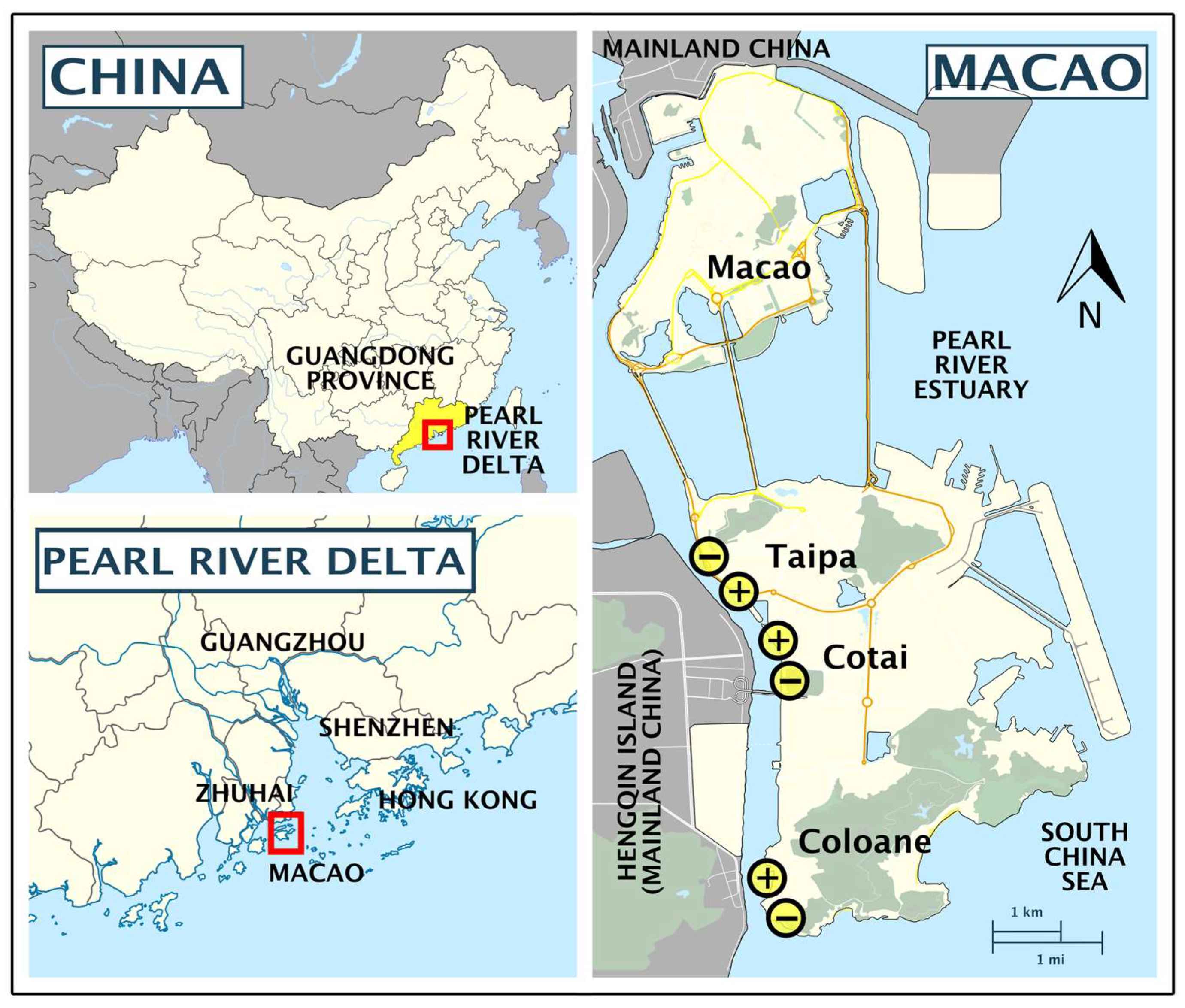

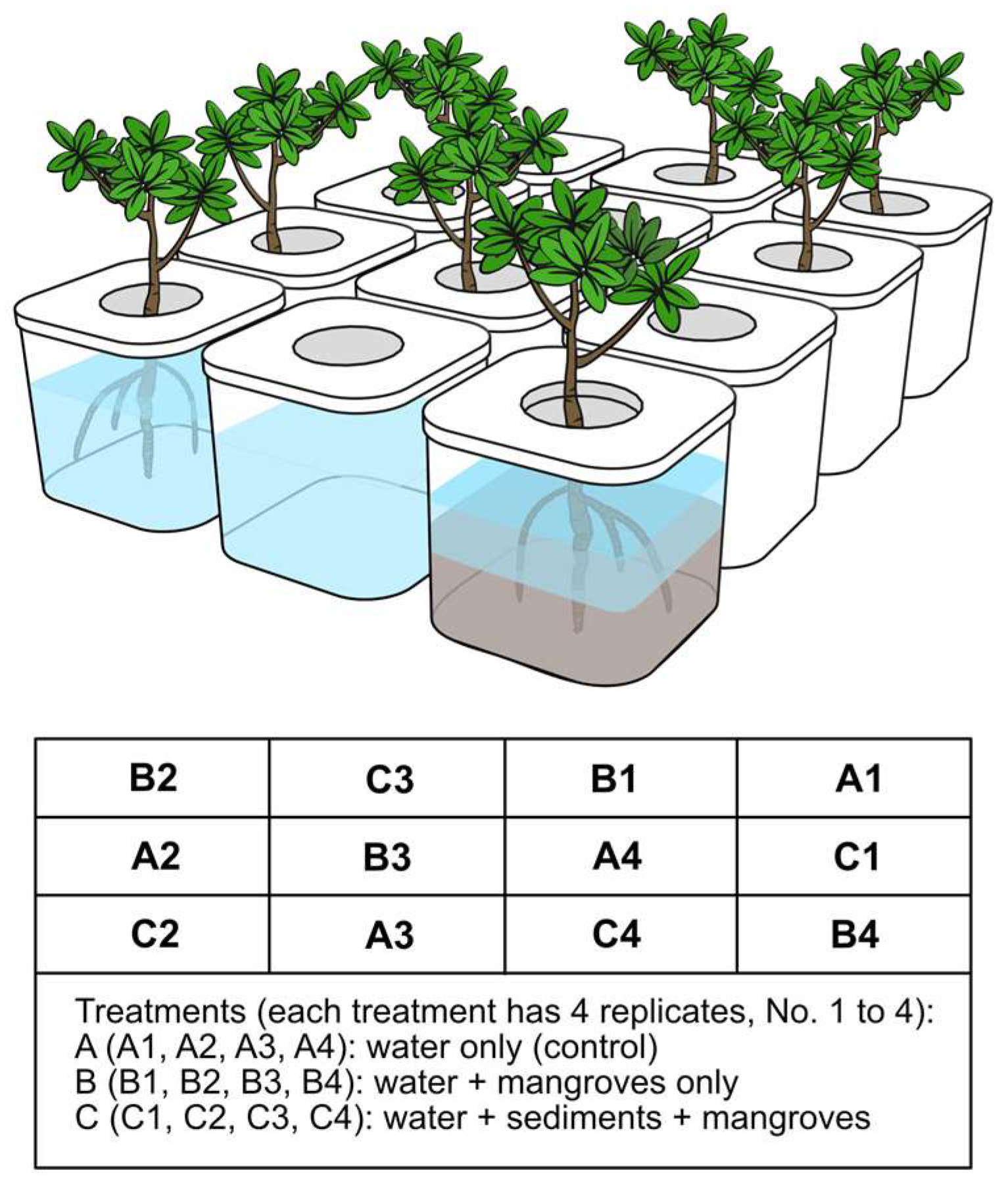
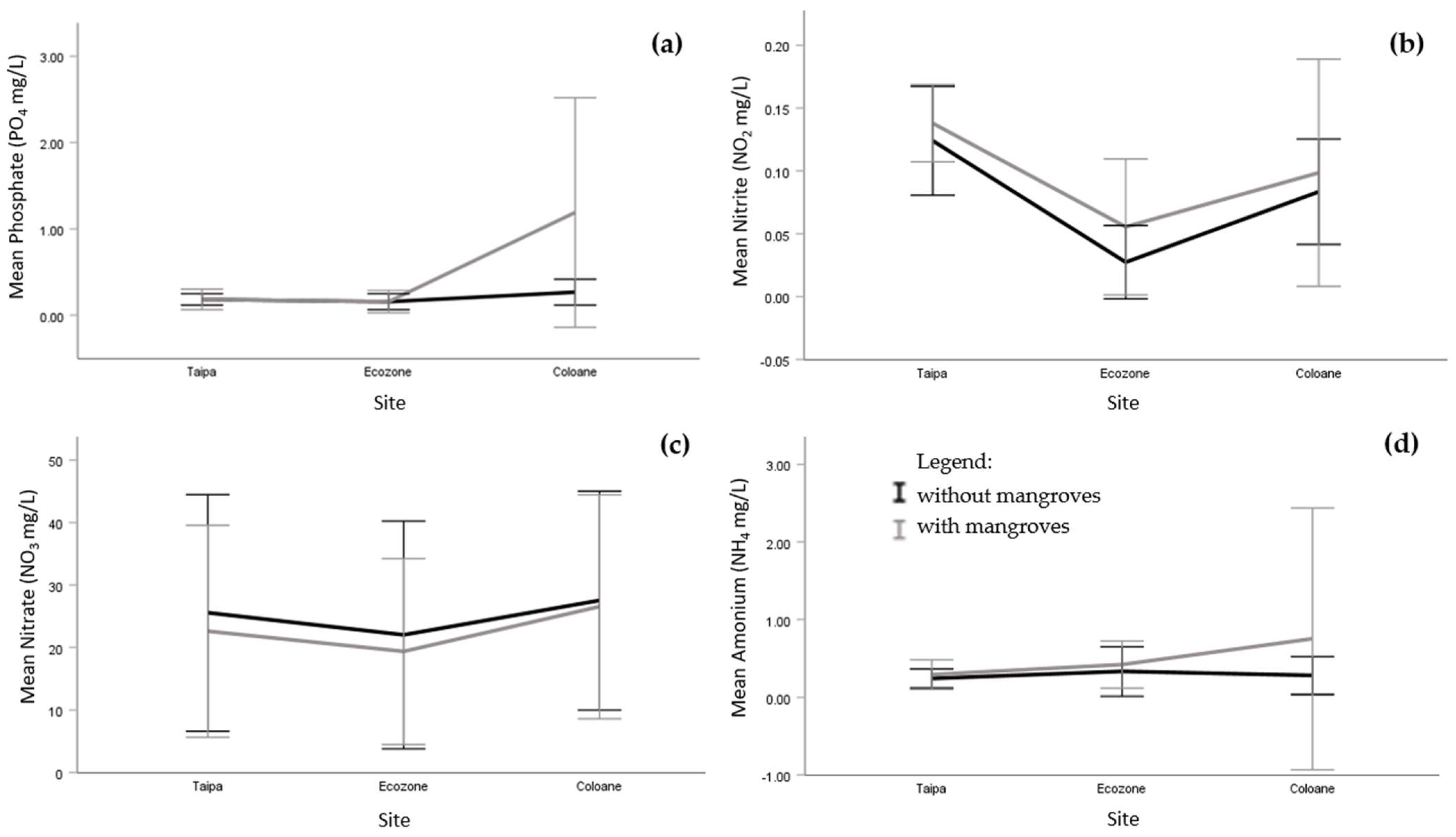
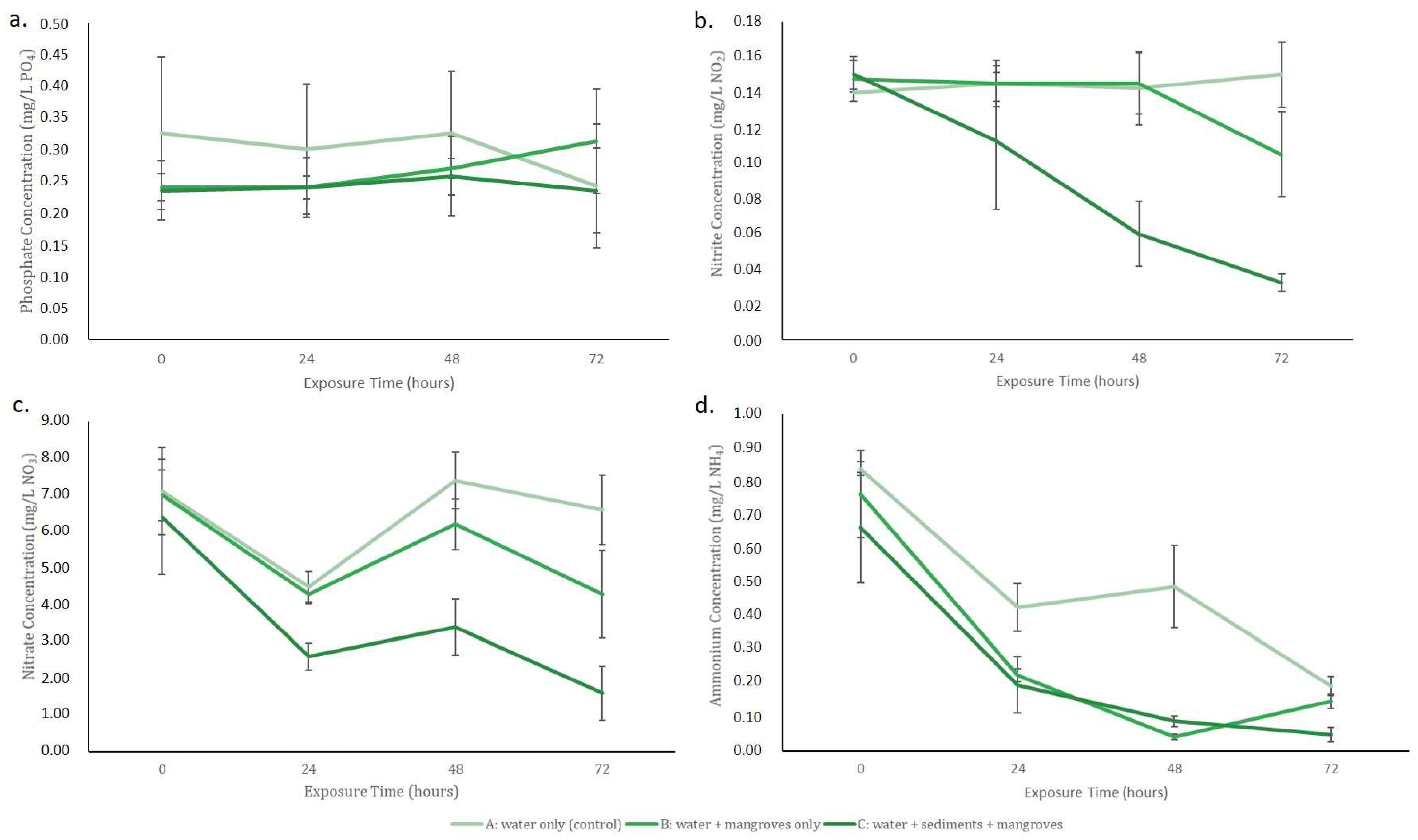
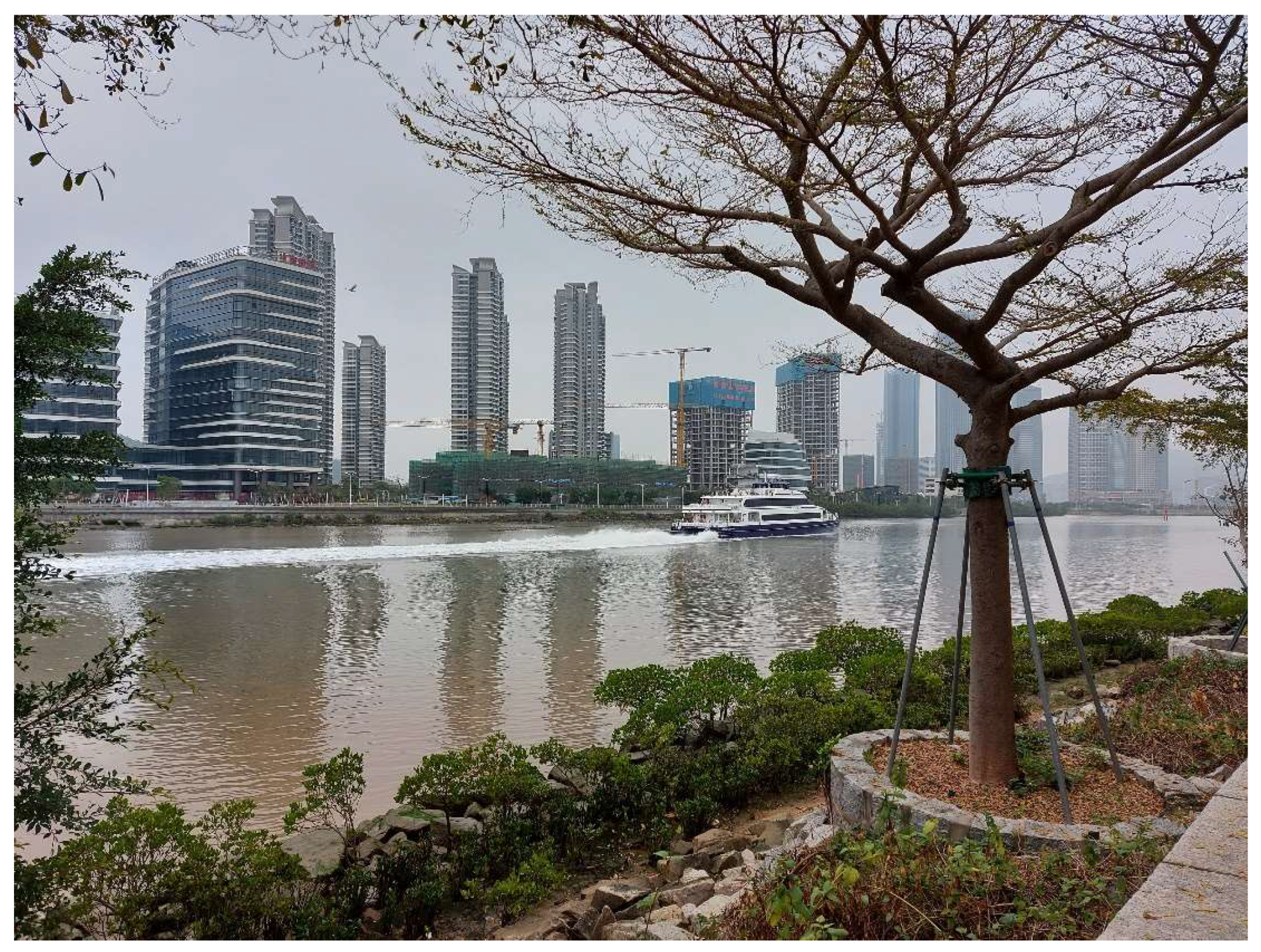
| Salinity (‰) | pH | Temperature (°C) | ||||
|---|---|---|---|---|---|---|
| Sites | Without Mangroves | With Mangroves | Without Mangroves | With Mangroves | Without Mangroves | With Mangroves |
| Taipa | 12.15 ± 5.60 | 10.56 ± 5.07 | 7.57 ± 0.28 | 7.63 ± 0.38 | 22.34 ± 3.80 | 22.25 ± 3.68 |
| Ecozone | 16.29 ± 5.58 | 16.36 ± 7.84 | 7.97 ± 0.38 | 7.70 ± 0.40 | 24.66 ± 4.30 | 24.44 ± 4.02 |
| Coloane | 14.37 ± 8.25 | 6.53 ± 4.68 | 7.96 ± 0.20 | 7.65 ± 0.17 | 24.55 ± 3.81 | 24.10 ± 3.76 |
| Parameters | ||||
|---|---|---|---|---|
| PO43− | NO2− | NO3− | NH4+ | |
| Site | 17.475 *** | 34.279 *** | 1.123 | 1.315 |
| Mangroves | 13.138 *** | 4.178 * | 0.420 | 2.791 |
| Site × Mangrove | 11.886 *** | 0.255 | 0.030 | 1.136 |
| Treatments | Salinity (‰) | pH | Temperature (°C) |
|---|---|---|---|
| A = water only (control) | 18.72 ± 0.15 | 8.08 ± 0.15 | 26.32 ± 3.10 |
| B = water + mangroves only | 18.67 ± 0.18 | 7.94 ± 0.10 | 26.22 ± 3.04 |
| C = water + sediments + mangroves | 15.38 ± 1.83 | 7.97 ± 0.26 | 25.78 ± 2.64 |
| Parameters | ||||
|---|---|---|---|---|
| PO43− | NO2− | NO3− | NH4+ | |
| Time | 0.411 | 17.370 *** | 30.530 *** | 155.300 *** |
| Treatments | 2.074 | 43.305 *** | 45.354 *** | 41.531 *** |
| Time × Treatments | 0.968 | 10.708 *** | 5.130 *** | 5.607 *** |
Disclaimer/Publisher’s Note: The statements, opinions and data contained in all publications are solely those of the individual author(s) and contributor(s) and not of MDPI and/or the editor(s). MDPI and/or the editor(s) disclaim responsibility for any injury to people or property resulting from any ideas, methods, instructions or products referred to in the content. |
© 2023 by the authors. Licensee MDPI, Basel, Switzerland. This article is an open access article distributed under the terms and conditions of the Creative Commons Attribution (CC BY) license (https://creativecommons.org/licenses/by/4.0/).
Share and Cite
Tagulao, K.A.; Lai, W.I.; Lebel, A.; Calheiros, C.S.C. Evaluating the Potential of Mangrove Phytoremediation for Mitigating Coastal Water Eutrophication in Macao SAR: A Field and Mesocosm Study. Sustainability 2023, 15, 7830. https://doi.org/10.3390/su15107830
Tagulao KA, Lai WI, Lebel A, Calheiros CSC. Evaluating the Potential of Mangrove Phytoremediation for Mitigating Coastal Water Eutrophication in Macao SAR: A Field and Mesocosm Study. Sustainability. 2023; 15(10):7830. https://doi.org/10.3390/su15107830
Chicago/Turabian StyleTagulao, Karen Araño, Wai Ian Lai, Alexandre Lebel, and Cristina Sousa Coutinho Calheiros. 2023. "Evaluating the Potential of Mangrove Phytoremediation for Mitigating Coastal Water Eutrophication in Macao SAR: A Field and Mesocosm Study" Sustainability 15, no. 10: 7830. https://doi.org/10.3390/su15107830
APA StyleTagulao, K. A., Lai, W. I., Lebel, A., & Calheiros, C. S. C. (2023). Evaluating the Potential of Mangrove Phytoremediation for Mitigating Coastal Water Eutrophication in Macao SAR: A Field and Mesocosm Study. Sustainability, 15(10), 7830. https://doi.org/10.3390/su15107830







